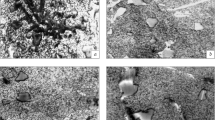Abstract
The evolution of eutectic carbide in as-cast M2 high speed steel was investigated with hot compression test and metallographic examination. Initial rodlike or irregular eutectic carbides were broken into smaller particles during hot deformation by thermomechanical disintegration, while diffusion-controlled phase transformation was not remarkable. Combining with numerical simulation, the relationship between breakdown ratio of carbide network and deformation parameters was obtained. Strain was the most important driving force to shatter eutectic carbides and disperse products. Furthermore, critical strain values were obtained, beyond which carbide network disappeared, and fractured carbides kept a stable profile and they were deformed with matrix coordinately. A higher temperature or lower strain rate resulted in a lower critical strain.
Similar content being viewed by others
References
Imbert C A C, Ryan N D, McQueen H J. Hot Workability of Three Grades of Tool Steel [J]. Metallurgical Transactions: Physical Metallurgy and Materials Science, 1984, 15A (10): 1855.
Imbert C A C, McQueen H J. Dynamic Recrystallization of A2 and M2 Tool Steels [J]. Materials Science and Engineering, 2001, 313A(1/2): 104.
Imbert C A C, McQueen H J. Peak Strength. Strain Hardening and Dynamic Restoration of A2 and M2 Tool Steels in Hot Deformation [J]. Materials Science and Engineering, 2001, 313A(1/2): 88.
LIU Jian-tao, CHANG Hong-bing, WU Rui-heng, et al. Investigation on Hot Deformation Behavior of AISI T1 High-Speed Steel [J]. Materials Characterization, 2000, 45 (3): 175.
Ghomashchi M R, Sellers C M. Microstructural Changes in As-Cast M2 Grade High Speed During Hot Forging [J]. Metallurgical Transactions, 1993. 24A(10): 2171.
Ghomashchi M R. Quantitative Microstructural Analysis of M2 Grade High Speed Steel During High Temperature Treatment [J]. Acta Materialia, 1998, 46(4): 5207.
Lee E S, Park W J, Jung J Y, et al. Solidification Microstructure and M2C Carbide Decomposition in a Spray-Formed High-Speed Steel [J]. Metallurgical and Materials Transactions: Physical Metallurgy and Materials Science, 1998, 29A(5): 1395.
Rodenburg C, Krzyzanowski M, Beynon J H, et al. Hot Workability of Spray-Formed AISI M3: 2 High-Speed Steel [J]. Materials Science and Engineering, 2004, 386A(1/2): 420.
YAN Fei, SHI Hai-sheng, JIN Bing-zhong, et al. Microstructure Evolution During Hot Rolling and Heat Treatment of the Spray Formed Vanadis 4 Cold Work Steel [J]. Materials Characterization, 2008, 59(8): 1007.
Roebuck B, Lord J D, Brooks M, et al. Measurement of Flow Stress in Hot Axisymmetric Compression Tests [J]. Materials at High Temperatures, 2006, 23(2): 59.
NIU Ji-tai, Physical Simulation in Materials and Hot-Working [M]. Beijing: National Defense Industry Press, 2007 (in Chinese).
Parteder E, Bunten R, Determination of Flow Curves by Means of a Compression Test Under Sticking Friction Conditions Using an Iterative Finite-Element Procedure [J]. Journal of Materials Processing Technology, 1998, 74(1/2/3): 227.
LIN Xin-bo, ZHAI Fu-bao, ZHANG Zhi-Iiang. Determination of Metal Material Flow Stress by the Method of C-FEM [J]. Journal of Materials Processing Technology, 2002, 120(1/2/3): 144.
Inc Dynamic Systems. Recommeded Physical Simulation Procedures Using GLEEBLE Systems [M]. New York: Poestenkill, 2003.
ZHOU Bin, SHEN Yu, CHEN Jun, et al. Correction of the Metallic Material Flow Curves [J]. Journal of Shanghai Jiaotong University, 2009, 43(5): 722 (in Chinese).
Corp Scientific Forming Technology. DEFORM-2D User Manual [M]. Oh: Columbus, 2006.
Antretter T, Fischer F D. Critical Shapes and Arrangements of Carbides in High-Speed Tool Steel [J]. Materials Science and Engineering, 1997, 237A(1): 6.
Author information
Authors and Affiliations
Corresponding author
Additional information
Foundation Item: Item Sponsored by National Key Basic Research and Development Program of China (2006CB705401); National Natural Science Foundation of China (50675133)
Rights and permissions
About this article
Cite this article
Zhou, B., Shen, Y., Chen, J. et al. Breakdown Behavior of Eutectic Carbide in High Speed Steel During Hot Compression. J. Iron Steel Res. Int. 18, 41–48 (2011). https://doi.org/10.1016/S1006-706X(11)60009-5
Received:
Published:
Issue Date:
DOI: https://doi.org/10.1016/S1006-706X(11)60009-5



